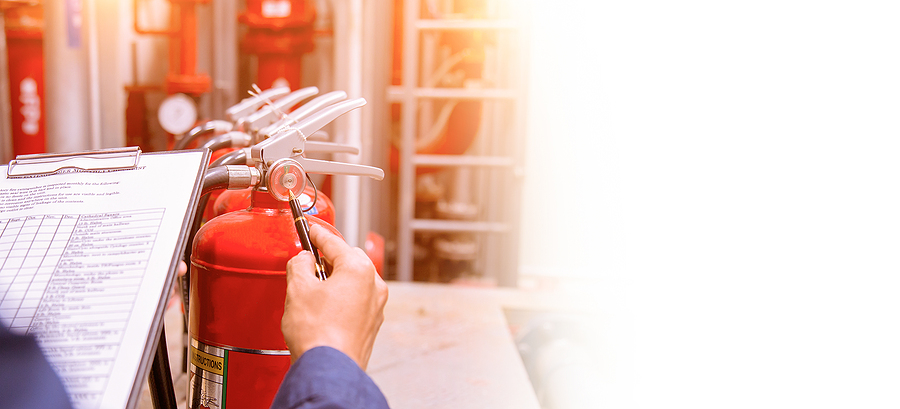When it comes to preventing fires, being proactive is crucial. Unfortunately, most problems with fire safety systems come from not inspecting and testing them routinely.
As the owner of a building, you need to take the initiative and create a program for regular maintenance, testing, and inspection. If not, issues like broken fire pumps or sprinkler valves can be disastrous.
Your sprinkler system working properly is extremely important. Make inspecting your fire sprinklers a weekly routine. Hiring a professional to do a comprehensive annual inspection is a must.
The National Fire Protection Association (NFPA) demands that dry and wet systems be tested every 5 years and dry systems alone be fully tested every 3 years. However, the NFPA Standard 25 for Inspecting, Testing and Maintaining Water-Based Fire Protection says certain weekly, monthly, quarterly and annual checks are needed.
Weekly Inspection Procedures
- Check main lines and branches in freezing areas to ensure proper operation.
- Visually inspect all fire doors to confirm no obstructions and proper functioning.
- Inspect and test automatic and manual fire alarms.
- Look at gauges on dry, pre-action, and deluge systems to verify normal air and water pressure.
Monthly Inspections
- In addition to weekly checks, also do:
- Carefully inspect all control valves to confirm accessibility, no exterior leaks, and normal position.
- Check gauges on wet pipe systems to verify proper water pressure and operation.
Quarterly Fire Sprinkler Inspections
- For hydraulically designed sprinkler systems, verify that the hydraulic design information plate is intact, legible, and securely attached to the riser assembly.
- Functionally test all water flow detection and alarm devices to ensure they are in good condition and capable of activating all associated alarms and notifications upon detecting water flow.
- Thoroughly inspect the position and condition of pressure regulating valves. Verify they are in the precise open position required for proper system operation. Confirm that no leakage or other anomalies are present.
- Mechanical water motor gong alarm devices should be manually tripped and tested on a quarterly basis. For systems equipped with vane type or pressure switch type water flow alarms, semi-annual testing and inspection is acceptable.
- Carefully inspect all fire department sprinkler and standpipe system connections to ensure they are properly located, conspicuous, and remain completely accessible. Confirm that no physical damage has occurred and that all couplings, caps, and connections are intact and in good working order. Perform hydraulic flow tests if any deficiencies are suspected.
Annual Fire Sprinkler System Inspections
NFPA 25 requires extensive and thorough annual testing procedures and inspections that should only be carried out by factory certified sprinkler contractors owing to their complexity. The following annual tests and inspections are mandatory:
- All sprinkler heads, pipe hangers, water distribution pipes, fittings, risers, and other components must be closely inspected to identify any damage, leakage, corrosion, or other deficiencies that may impact system performance and reliability.
- Main drain tests must be conducted on all sprinkler systems to verify control valves are in the full open position and water flows properly through the main drain assembly. Valve position indicators must be confirmed.
- Dry pipe valves must undergo a partial trip and full trip test, internal inspection, cleaning, lubrication, and resetting to confirm functionality. Lost air and water pressures and trip times must be compared to factory specifications.
- Deluge valves must have an annual full flow trip test conducted. The maximum time interval between consecutive full flow trip tests for deluge valves must not exceed 3 years.
- Sample testing must be done on each separate antifreeze solution system to verify the concentration level is within the acceptable range. Solutions must be properly adjusted accordingly.
- All nozzles on open head water spray systems must be visually inspected to identify any buildup of foreign material or other blockages. Functionally test a representative sample to verify proper spray pattern and flow.
- The main water supply strainer assembly must be isolated, removed, and visually inspected internally for any signs of gap corrosion or damaged screen mesh. All defective components must be replaced immediately.
Contact Brazas Fire for Serious Inspection
Any leaking, corroded, damaged or fluid-losing sprinkler must be replaced. Not routinely testing and inspecting can leave your building completely vulnerable during a fire.
Partnering with Brazas Fire ensures routine checks and testing so your systems function properly at all times. Being proactive saves lives and property.
